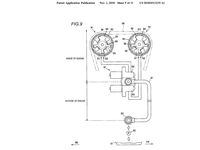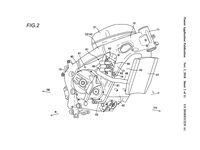One of the main talking points of Suzuki’s 2017–later GSX-R1000 is the innovative all-mechanical variable valve timing system that it inherited from the firm’s GSX-RR MotoGP bike. But now new patent applications suggest the firm has plans to drop that setup in favor of a more conventional hydraulic VVT system that would potentially offer benefits in terms of both performance and midrange drivability.
The GSX-R1000’s VVT is unlike any other system on the market. It’s a cam-phasing setup, which allows the timing of the intake camshaft to be advanced or retarded by a few degrees depending on engine revs. That’s not exceptional in itself; the intrigue comes in the method Suzuki has employed to achieve that movement. Other cam-phasing VVT bikes—notably the Ducati Multistrada and Diavel with their DVT (Desmodromic Variable Timing) engines, but also Kawasaki’s 1400GTR (Concours in the US)—use hydraulics to advance or retard the timing; Suzuki’s GSX-RR VVT, later passed down to the GSX-R1000 roadbike, was developed specifically for MotoGP where hydraulic and electronic VVT systems are expressly forbidden. To skirt that ban, Suzuki uses centrifugal force to achieve its cam phasing.
Briefly, the intake cam sprocket is engaged with a matching-sized plate on the end of the intake camshaft. Both the sprocket and the plate are machined with radial grooves, in which sit heavy metal balls. On one face, the radial grooves are straight, while on the other they’re curved. That means that when the metal balls are flung outward by centrifugal forces, the camshaft is rotated by a few degrees in relation to the sprocket. The grooves are shallower at the outer edges and the two mating faces are forced together by a spring, so when revs drop and the camshaft slows down, the balls are pushed back toward the middle, bringing the cam timing back to its initial point.
It’s a clever system if you need to avoid rules banning electronic control or hydraulic actuation but on a road-going superbike with no such restrictions, there are drawbacks. In particular, the only ways to alter the moment at which the cam timing is changed is by changing the mass of the metal balls or the strength of the spring that forces them back to the center.
In contrast, the hydraulic cam-phasing systems used by Ducati, Kawasaki, and endless car manufacturers are actuated when a computer-controlled solenoid allows oil to enter chambers in the cam sprocket, forcing the camshaft to rotate a fraction in relation to it. Since the engine-management computer controls the solenoid that releases the oil into the cam phasers, it’s easy to tweak when the cam timing is changed, and by how much it advances or retards at preset revs.
The new Suzuki patent applications clearly show a GSX-R1000 fitted with an electronically operated hydraulic cam-phasing system, very similar to the one used by Ducati. As well as the benefit of increased control over the cam timing, the new Suzuki design also adds VVT to the exhaust camshaft, which has fixed valve timing on the current GSX-R1000. Although changing the exhaust cam timing has less effect on performance than the intake camshaft, it still offers benefits, particularly when it comes to meeting strict emissions limits.
While there’s nothing new to be patented in the basic design, Suzuki has seen fit to apply for several patents around the system, mainly revolving around the positioning of the hydraulic control valves, which are bolted to the side of the cylinder head. The intention here is to improve cooling to the hydraulics, making sure the oil retains a consistent viscosity so the VVT’s behavior is as predictable and controllable as possible.
Variable valve timing looks likely to become the next major battleground for superbikes. High-revving, high-performance, multi-cylinder engines are among the toughest to get past emissions rules. With Euro 5 emissions regulations planned in Europe in the next couple of years, it’s going to be increasingly difficult for high-powered engines with fixed valve timing to remain on sale; they will most likely have to adopt VVT to help reduce valve overlap at low revs. If Suzuki makes the switch to hydraulic VVT on both camshafts, as illustrated in its patent application, it will make it far easier to keep the GSX-R1000 ahead of tighter emissions rules without sacrificing peak power.
Suzuki’s patent text also makes it clear that while it illustrates the system on an inline four-cylinder, it wants to be able to use it on a range of designs including singles, parallel twins, and V engines.
/cloudfront-us-east-1.images.arcpublishing.com/octane/QKUFRT4YGMCJYRBHY6M34JRWCM.jpg)



/cloudfront-us-east-1.images.arcpublishing.com/octane/N575KB7BDZDPPJBRLZRG2ANHKI.jpg)
/cloudfront-us-east-1.images.arcpublishing.com/octane/T77HXRXV4NGKDNZODMSEIBRXPE.jpg)
/cloudfront-us-east-1.images.arcpublishing.com/octane/NKMM7V2P3BCSXAV6J56FKK67OU.jpg)
/cloudfront-us-east-1.images.arcpublishing.com/octane/SWQRQV27DNFA7LXGFI7FNFNGOQ.jpg)
/cloudfront-us-east-1.images.arcpublishing.com/octane/GYEXUJBV5JGQLLZNXO7KRVSTEY.jpg)
/cloudfront-us-east-1.images.arcpublishing.com/octane/MCWUSJJVJVG45P7QQG3WOXZR54.jpg)
/cloudfront-us-east-1.images.arcpublishing.com/octane/AJ4EFPH2CRDURDAB5LPEA2V2NE.jpg)
/cloudfront-us-east-1.images.arcpublishing.com/octane/LSDHIL22SZAFFPYLKP5ZXLJSIY.jpg)
/cloudfront-us-east-1.images.arcpublishing.com/octane/SH46HIOX4RELXLXF6AE3SFGH4A.jpg)
/cloudfront-us-east-1.images.arcpublishing.com/octane/JUZ52WFWLJGMNH7PGZNOKP3MUY.jpg)












